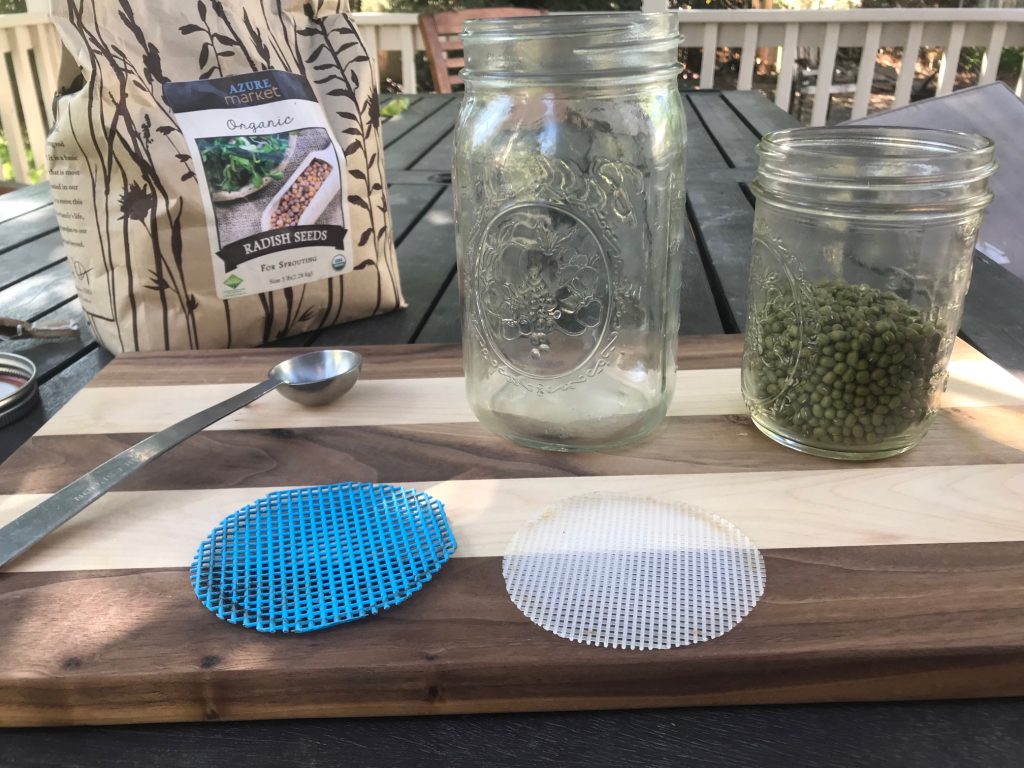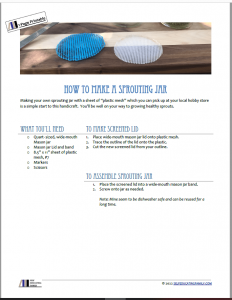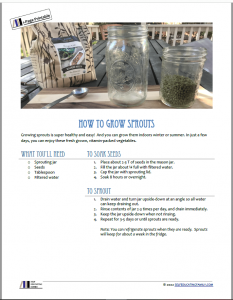Growing Sprouts in a Jar – Handicraft for Kids
Growing Sprouts in a Jar
Welcome to Growing Sprouts in a Jar. We’ll look at the mechanics of sprouting, discuss safety procedures, make your own sprouting jars, and then grow some sprouts.
Let’s get started with this nutritious and economical foray into growing your own sprouts in a jar!
Table of Contents
- Growing Sprouts in Jars
- Safety
- Growing Sprouts in a Jar – Handicraft with kids
- How to Charlotte-Masonize this handicraft
Growing Sprouts in Jars
How do I grow sprouts in a jar at home?
Growing sprouts in a jar at home is as easy as putting some seeds in a jar, soaking the seeds, then rinsing the seeds. Let’s take a look at the specifics and then get sprouting.
What is a sprout?
The seed will grow a little tail when it starts to germinate. If the seed were planted, this would become the root. The seed will then grow the part of the plant that would become the stem, cotyledons, and then true leaves. In general, when people harvest their sprouts, there is a tail and sometimes the cotyledons.
What’s the difference between sprouts and microgreens?
Microgreens grow a little bit longer than sprouts – they will have the cotyledons and sometimes the first true leaves. They will be green*– photosynthesis has started. *Technically, microgreens can be other colors besides green, depending on the seed, like red amaranth or red leaf lettuce.
Because microgreens will use photosynthesis, they need sunlight. Sprouts don’t need light since you usually harvest them before they have leaves.
Microgreens grow in soil or another medium, where sprouts don’t need anything but water and rinsing.
How long does it take to grow sprouts?
Your seeds will sprout in a few days. It just depends on the seed. Generally, seeds will be ready in 3 to 7 days.
| Seed | Time |
| Alfalfa | 5-6 days |
| Broccoli | 3-6 days |
| Clover | 5-6 days |
| Peas | 2-3 days |
| Mung Beans | 2-5 days |
| Radish | 3-6 days |
| Sunflower | 1-2 days |
| Lentil | 2-3 days |
Length of time to Grow Most Popular Sprouts in a Jar
Source: Sproutpeople.com
Sproutpeople have some fantastic instruction guides for each type of seed that they sell. I’ve never tried them as a source, but their information is thorough. They also recommend adjusting the “harvest” time according to your personal tastes. Just start tasting the harvest every day. As long as you keep rinsing, your harvest will just keep growing.
I actually prefer my radish sprouts towards the longer growing time. And I’ve accidentally needed to keep growing my mung beans until well past the harvest when the cotyledons were fully formed and green. The sprouts were still delicious in a stir-fry!
What kind of jars do I use?
Any jar will work with cheesecloth and a rubber band to do the rinsing/draining. Clear jars work better in order to see what’s going on.
I prefer mason jars because I’ve made some sprouting jars that work with mason jar bands. See below for how to make your own sprouting jar.

Do sprouts need sunlight?
As mentioned, sprouts do not need light to grow. But they don’t mind too much either if they are growing on the kitchen counter with ambient light or sunlight. The one thing to beware of is heat – if you have your jar in a spot where it can get overheated, you can dry out the sprouts unintentionally.
What kind of sprouts should I grow?
For just starting out, try mung beans. They are very easy and relatively mild-tasting. If you’ve ever bought sprouts in the store, try growing the same variety that you like to eat.
How do I know when my sprouts are ready to eat?
Taste your sprouts to see if you like how they taste. Sprouts are ready once they have soaked up some water and start growing that little tail. Some people sprout grains, then dry them and grind them into flour.
The sprouting process begins by changing the seed from its dormant stage (with less available nutrition) to the growing stage in which its enzymes begin to be activated. Once those enzymes are going, the seed becomes easier to digest.
I soak and sometimes sprout my chicken feed which is a mix of whole grains (wheat, barley, oats) and peas (along with a few other add-ins). The chickens benefit from the extra nutrition in their feed. Technically, I could eat their soaked and sprouted feed, but I don’t.
Are sprouts a superfood?
It’s hard to talk sprouts without mentioning the hubbub about how good they are for you. Superfood label or not, sprouting takes a dormant seed that has all of its nutrition locked up inside it and changes it to more bio-available nutrients.
| Nutrient | Sprout | Mature Plant | |
| Vitamin A | 59.5 mcg | 6.08 mcg | |
| Vitamin K | 40.5 mg | 35.6 mg | |
| Calcium | 51.5 mg | 35 mg | |
| Sulforaphane | 20 -100x more | ||
Nutrition information for Broccoli
Source: foodnurish.com
This is just broccoli. And admittedly, some nutrients are more available in the mature broccoli plant, like vitamin C and protein. But in general, many nutrients become more bio-available while a plant is in the supercharged-growing phase.
Safety
When it comes to sprouts, you want to make sure you are eating a healthy vegetable and not contaminating it with something you’ve done. Use common sense, clean jars and normal food safety rules.
How do I sterilize my jars?
Always use clean jars. You can sterilize your mason jars in the dishwasher. I find that the easiest, but some people prefer to boil their jars as if they were canning.
If you are using cheesecloth, keep it sanitized (boiled) between uses or use once. I use a plastic mesh lid, which I throw in the dishwasher to sanitize. If you are using a special spouting rack, make sure it can be sterilized in the dishwasher between uses.
How often do I rinse my sprouts?
“Rinsing is the process by which we add moisture to our sprouts. Draining is the process by which we regulate the amount of moisture our sprouts have available – until their next Rinse.”
—SPROUTPEOPLE
Most sprouts will start with a 4 -12 hour soak and then be rinsed 3x per day. Some people advocate 2 rinses a day. The purpose of the rinse is to keep those sprouts moist and growing. They cannot sit in a puddle of water, or they will mold. Most people who use jars will tilt the jar upside-down to drain the rinse water off between rinses.
According to Rusticwise, too much water (a.k.a. poor drainage or puddling) will “drown” the sprouts or make moldy or slimy sprouts; and too little water can kill the sprouts because they get too dry.
Can I use tap water to rinse my sprouts?
While I prefer to use filtered tap water, some people have found that tap water is fine for sprouting if your tap water is free from chlorine and other chemicals. Some people find that hard water is also problematic for sprouting. Know your water – healthy in yields healthy out.
Is it safe to eat raw sprouts?
Many people ask this because the FDA linked sprouts to more than 50 outbreaks of food-borne illnesses over the course of 25 years. They also came out with “Guidance for Reducing Food Safety Hazards in the Production of Seed for Sprouting” in 2019.
I’ve read both sides of the argument and disclaimer – I am not offering any advice whatsoever. Do your own research. It seems to me to be a political issue for something that has been done for centuries or millennia even. When you read both sides of the argument, the source of contamination seems to come from contaminated seed, which means seeds that come in contact with raw manure. Since organic farming methods never use raw manure on food crops (they use cured or composted manure), I highly recommend only purchasing organic seed, preferably from a trusted US source! I get much of my seed from Azure, but I’ve also gotten some from other sources. Organic seeds won’t be contaminated.
How do you store sprouts?
I usually eat my sprouts as fast as I grow them, but I will put them in the fridge for a day or two if I have extra. Wardee Harmon at Traditional Cooking School has a good article on this if you’d like more information.
How do you know if sprouts are bad?
If your sprouts smell funny or have mold, or are slimy, toss them into the compost! Just as you would any vege that you’ve left too long in your fridge – not that any of us have ever done that!
Mold = Bad
An “off” smell = Bad
Slime = Bad (unless you are trying to sprout chia or flax, which are mucilaginous.)
Growing Sprouts in a Jar – Handicraft with kids
This handicraft has 2 parts – first make some jar lids, then you are ready to actually sprout. I’ve got a “One Page Printable” freebie for both of these that you can download from the library if you sign up for my newsletter.
This is a great handicraft to do with kids. It works for most ages. Growing a garden year-round indoors in very little space can be a fun and rewarding skill to learn.
Here are the instructions for making a sprouting jar and for growing sprouts in that jar.
How to Make a Sprouting Jar

Make your own sprouting jar with a sheet of “plastic mesh” which you can pick up at your local hobby store.
Materials & Equipment
- Quart-sized, wide-mouth Mason jar
- Mason jar Lid and band
- 8.5” x 11” sheet of plastic mesh, #7
- Markers
- Scissors
Steps
- Place wide-mouth mason jar lid onto plastic mesh.
- Trace the outline of the lid onto the plastic.
- Cut the new screened lid from your outline.
- Place the screened lid into a wide-mouth mason jar band.
- Screw onto the jar as needed.
Download the free printable
If you are already signed up for the newsletter, access the library to download “How to Make a Sprouting Jar”.
Growing Sprouts in a Jar

Now, you are ready to sprout.
Material & Equipment
Download free printable from the library
- Sprouting jar
- Seeds
- Tablespoon
- Filtered water
Steps
- Place about 2-3 T of seeds in the mason jar.
- Fill the jar about ¾ full with filtered water.
- Cap the jar with sprouting lid.
- Soak 8 hours or overnight.
- Drain water and turn jar upside-down at an angle so all water can keep draining out.
- Rinse contents of jar 2-3 times per day, and drain immediately.
- Keep the jar upside-down when not rinsing.
- Repeat for 3-5 days or until sprouts are ready.
Download the free printable
If you are already signed up for the newsletter, access the library to download “How to Grow Sprouts”.
How to Charlotte-Masonize this handicraft
The most remarkable observation about growing sprouts is that they grow FAST. To apply Charlotte Mason principles to growing sprouts in your sprouting jar, keep the following things in mind:
- Short lessons: Sprouting is ideally suited to short lessons – rinse with water, turn the jar over, and it’s done. Less than 5 minutes two or three times a day.
- Encourage the habit of observation: You can play one of Charlotte Mason’s favorite games – send the child over to observe the seeds, and have them “narrate” what they see or what has changed.
- Option to add drawing: You can pull out the sprouts for nature study and keep a timeline of the seed growth.
- Option to add photography: older students sometimes enjoy photographing the sprouts or setting up a time-lapse animation of the seeds.
- Conclude the sprout growing by cooking something yummy to eat like Broccoli Sprout Salsa or Bean Sprout Stir Fry with Ginger and Scallion, recipes found at Cultures for Health. Encourage your child to find and make a new recipe.
For Further Study
If that wasn’t enough detail for you, here are the resources I’ve gathered for you to use.
Growing sprouts in jars
- How to sprout seeds in a jar
- Growing Sprouts Tutorial
- How to grow sprouts
- How to sprout at home
- Growing sprouts
- Sprouting basics
- Grow sprouts at home
Sprouting safety
- Clean sprouting
- How to grow Non-slimy Broccoli sprouts
- Two tricks to prevent mold in sprouts
- Rinsing properly
- Raw Sprouts: Benefits and Risks
- 7 safety tips
- Food Safety Guidance
- Are sprouts safe?
- Sprout safety factsheet
- Raw vs. Boiled Safety
- FDA
- How to rinse and store sprouts
- Raw Sprouts: Good or Bad?
